Perceived Benefits of Energy Efficiency in the Spanish Residential Market and Their Relation to Sociodemographic and Living Conditions
Abstract
Featured Application
Abstract
1. Introduction
- (1)
- Whether the link between energy efficient homes and their co-benefits in the form of energy savings and comfort is fully established among respondents
- (2)
- Whether such co-benefits are contingent to the current living conditions expressed as priorities of home improvements including those related to energy-efficiency
- (3)
- Whether such co-benefits are correlated with sociodemographic information of respondents and preferred tenure regime
2. Barriers to Energy Performance Diffusion, The Role of Perceived Benefits and Past Research in Spain
2.1. Barriers to Energy Performance Diffusion
- Economic barriers; as the lack of economic or tax incentives (which in Spain is worsened by the dispersal of local, regional and state regulations and jurisdictions), the incremental cost of the design and construction of a new building when it includes a comprehensive study on energy performance, the uncertainty of energy savings and the long payback periods.
- However, the barriers go beyond economic aspects since there are socio-cultural barriers embedded, such as the lack of public awareness or the change resistance of the construction industry.
- There are also technical barriers regarding the inadequate technical training; the projects dispersion and diversity or the scarce data about the projects’ performance, not to mention the green-wash that is still used by many companies when mentioning just one building energy performance improvement, hiding or neglecting the relevance of other issues [11].
2.2. The Role of Perceived Benefits
- Humidity: As example, Fraunhofer IBP (2016) estimates that 2.2 million Europeans have asthma as a direct result of living in damp or moldy buildings [25].
- Indoor air quality: The survey carried by Universitat de Barcelona–Hospital Clínic (Interstitial Diffuse Lung Disease Programme), shows thorough quantitative and qualitative evidence of the relationship between lung diseases and microorganisms present in air indoors. China provides another case where indoor air pollution is estimated to cause some 1.6 million premature deaths per year [26].
2.3. Past Research in Spain
3. Case Study, Materials and Methods
- (1)
- Population of the municipality where respondents live (Padrón de Población, INE, 2019). This information allows to identify any difference coming from the size of property markets and cultural influences (e.g., environmental awareness) coming from urban environments; and whether such co-benefits are contingent to the current living conditions expressed as priorities of home improvements including these related to energy-efficiency.
- (2)
- Household and personal income level (Income Tax Registry, INE, 2016) at census tract level. This information allows us to identify any bias provided by the self-declared household income level in the survey.
- (3)
- Heating and Cooling Index (EHI and ECI) of the municipality where the respondent lives (European Hot and Cool Market from Euroheat.org). This information intends to control opinion differences coming from climatic divergences in the country. The EHI and ECI are normalized indexes (100 = average European condition) from the degree days for heating and cooling. “Heating degree days” is a measure of how much (in degrees), and for how long (in days), outside air temperature was lower than a specific “base temperature” (see details in Ecoheatcool [40,41]). It is used for calculations relating to the energy consumption required to heat buildings. “Cooling degree days” is a measure of how much (in degrees), and for how long (in days), outside air temperature was higher than a specific base temperature. The measure of “heating degree days” expresses the heat requirement for a specific period of time considering environmental and interior temperature providing a proper comfort level, the same is done for the “cooling degree days”. The larger the EHI and ECI indexes, the more the necessity to provide residential environments with heating and cooling.
4. Results and Discussion
4.1. Perceived Co-Benefits From Efficient Homes
4.2. Living Conditions as an Expression of Retrofit Requirements
- (1)
- In general, the older the respondents, the lower the requirement to implement specific retrofits in their current home. Such a finding suggests that living conditions improve as the residential carrier gains consolidation, although it also possibly masks some conformism regarding living conditions in the case of elder population. However, the requirement to improve envelope insulation (walls and windows) is largely irrespectively of the age of respondents.
- (2)
- Looking at homes requiring improvements, non-energy efficiency improvements, such as kitchen, bathroom or layout improvements, are less of a priority as the age of respondents’ increases. Interestingly, the exact inverse trend is observed in the case of window insulation which relevance becomes larger in the case of older respondents.
- (3)
- In general, women’s homes require less improvements than male respondents’ ones, thus female respondents exhibit better living conditions in relation to male respondents. Perhaps for this reason, women’s co-benefits perception is lower in relation to males’ one as discussed in the former section. Irrespectively of gender, the most required improvements concentrate on energy-efficiency passive actions, namely home envelope insulation.
- (4)
- Looking at homes requiring improvements, in both genders, energy-efficient improvements are of a greater priority than aesthetic-functional-accessibility ones, although women do place a larger priority on this than men. However, women prioritize non-energy efficient improvements (bathroom, kitchen and layout) to a larger extent than men, showing a clear gender influence probably linked to the way in how home duties are split between women and men. It is worth nothing that men place more importance to retrofits associated with the air-conditioning system.
- (5)
- As expected, the larger the income, the better the living conditions of respondents. As such, 93% of homes of households whose income is less than €1603 per month require retrofits; while homes of households making more than €3005 a month do require improvements in 85% of cases.
- (6)
- Considering only homes requiring retrofits, the priority to implement them decreases as the household incomes increases in almost all of the aspects assessed. Interestingly, this trend is reversed in the case of insulation, especially in the case of wall insulation which prioritization is statistically larger in the case of wealthier households.
- (7)
- Differences in living conditions among tenants and owners are compatible with the previously discussed transitory housing tenure. In general, tenants say their homes require retrofits to a larger extent than owners. Again, insulation issues are the most required in both regimes, although significantly more in the case of leased homes.
- (8)
- Looking only at homes requiring improvements, again the priority to implement them is higher in the case of tenants. By priority order the stated improvements are as follows: Passive systems, active and non-energy-efficiency ones. However, the households who own their home state that window/wall insulation has a larger priority than improving the kitchen, bathroom or the home layout.
4.3. Factors Influencing the Perception of Energy Efficiency Benefits
- (1)
- The main explanatory attribute is the priority to insulate respondents’ present home windows. The higher such priority, the larger the composite co-benefits associated with energy efficiency. It is worth recalling that window transmittance is the largest among enveloping elements in multifamily housing where poor-quality windows imply airflow infiltrations and external noise transmission. In that, the benefits of upgrading this element are of a multidimensional nature, as discussed in Section 2.2.
- (2)
- The second explanatory attribute concerns the socioeconomic context. The lower the respondent socioeconomic level, the less aware of the energy efficiency co-benefits. It is worth recalling the strong association in Spain between disposable family income and educational attainment, in that, well educated respondents do have better cognitive resources to understand the benefits of efficient premises even when they are not specialists.
- (3)
- The third most important explanatory factor is the indirect indicator of willingness to pay for efficient homes. In turn, respondents that think that efficient homes pursue a higher market value are also the most aware of energy efficiency implications. This finding is relevant since it empirically endorses the core hypothesis of the EPC scheme, regarding the relationship between energy transparency and prioritization of efficient premises in the form of a larger willingness to pay for them.
- (4)
- The fourth explanatory element is related to the priority to implement energy-efficient retrofits in heating/domestic hot water and air-conditioning systems. Respondents who consider this a priority in their current home are more aware of the composite benefits of energy efficiency.
- (5)
- Regarding demographic profiles, after having controlled for income, women are less aware of energy efficiency benefits as well as young respondents. These findings are a clear target for tailoring specific policies aimed at increasing energy performance awareness. The same is true regarding the role within the residential market, since the findings confirm that owners do place a large value on the benefits of energy efficiency in relation to tenants. It is worth recalling that women said in a larger proportion that their home does not require the assessed retrofits (i.e., their homes exhibit better living conditions in relation to male respondents’ home), so as suggested before, it is possible that this fact has influenced their response; although it is also possible that female respondents have a more optimistic perception of their homes in relation to male respondents. In the model, interaction variables between gender and living conditions were introduced, but none resulted statistically significant.
- (6)
- The positive relation between energy efficiency benefits awareness and the fact that respondents’ homes do not require the installation or improvement of air conditioners should be interpreted as an indirect indicator of climate conditions, since according to correlational analysis respondents indicating that their home do not require such appliance live in cooler regions where the energy demand for heating is relevant in winter.
5. Conclusions
Author Contributions
Funding
Data Availability Statement
Acknowledgments
Conflicts of Interest
References
- Balaras, C.A.; Gaglia, A.G.; Georgopoulou, E.; Mirasgedis, S.; Sarafidis, Y.; Lalas, D.P. European residential buildings and empirical assessment of the Hellenic building stock, energy consumption, emissions and potential energy savings. Build. Environ. 2007, 42, 1298–1314. [Google Scholar] [CrossRef]
- Jacques-Aviñó, C.; Dvorzak, J.L.; Marí-Dell’Olmo, M.; Arjona, D.R.; Peralta, A.; Carrere, J.; Benach, J.; Ramos, C.; Plana, M.; López, M.J. Qualitative evaluation of an intervention to reduce energy poverty. Rev. Saúde Pública 2019, 53, 62. [Google Scholar] [CrossRef]
- Bio Intelligence Service; Lyons, R. IEEP Energy Performance Certificates in Buildings and Their Impact on Transaction Prices and Rents in Selected EU Countries; European Commission (DG Energy): Paris, France, 2013; p. 158. [Google Scholar]
- Marmolejo-Duarte, C.; Chen, A. The Uneven Price Impact of Energy Efficiency Ratings on Housing Segments and Implications for Public Policy and Private Markets. Sustainability 2019, 11, 372. [Google Scholar] [CrossRef]
- Marmolejo Duarte, C.; Garcia-Hoohghuis, A.; Garcia-Masia, A. How Much Does the Energy Class of Our Dwellings Matter to Us? An analysis of The Level of Understanding of EPCs, Willingness to Pay and Reasons for Payment in Barcelona. Rev. Habitat Sustentable 2017, 7, 55–65. [Google Scholar]
- Marmolejo-Duarte, C.; Garcia-Hooghuis, A.; Garcia Masia, A. How much and why are we willing to pay for energy-efficient homes? A stated preferences analysis in Barcelona. ACE-Archit. City Environ. 2020, 14, 9215. [Google Scholar] [CrossRef]
- Ortiz, J.; Fonseca i Casas, A.; Salom, J.; Garrido Soriano, N.; Fonseca i Casas, P. Cost-effective analysis for selecting energy efficiency measures for refurbishment of residential buildings in Catalonia. Energy Build. 2016, 128, 442–457. [Google Scholar] [CrossRef]
- Marmolejo-Duarte, C.; Spairani-Berrio, S.; Del Moral-Ávila, C.; Delgado-Méndez, L. The Relevance of EPC Labels in the Spanish Residential Market: The Perspective of Real Estate Agents. Buildings 2020, 10, 27. [Google Scholar] [CrossRef]
- Pascual, R.P.; Paoletti, G.; Lollini, R. Impact and reliability of EPCs in the real estate market. Energy Procedia 2017, 140, 102–114. [Google Scholar] [CrossRef]
- Cañete, M.A. La eficiencia energética supone una oportunidad de 85,000 millones de euros en España. Revista Ecoconstrucción, 28 August 2019. [Google Scholar]
- Trebilcock, M. Percepción de barreras a la incorporación de criterios de eficiencia energética en las edificaciones. Rev. Constr. 2011, 10, 4–14. [Google Scholar] [CrossRef]
- Lambea Rueda, A.; Ruiz, M.; Pastor, G. La sostenibilidad de la vivienda: Razones para incentivar su desarrollo en España. Revesco 2020, 133. [Google Scholar] [CrossRef]
- García de Diego, M.D.L.; Gómez Muñoz, G.; Román López, E. Cuentas energéticas no habituales en edificación residencial-Towards new energy accounting in residential building. Inf. Constr. 2015, 67, m028. [Google Scholar] [CrossRef]
- Jevons, W.S. The Coal Question; An Inquiry Concerning the Progress of the Nation, and the Probable Exhaustion of our Coal-Mines. Fortnightly 1866, 6, 505–507. [Google Scholar]
- Ferreira, M.; Almeida, M.; Rodrigues, A. Impact of co-benefits on the assessment of energy related building renovation with a nearly-zero energy target. Energy Build. 2017, 152, 587–601. [Google Scholar] [CrossRef]
- Fuerst, F.; Oikarinen, E.; Harjunen, O. Green signalling effects in the market for energy-efficient residential buildings. Appl. Energy 2016, 180, 560–571. [Google Scholar] [CrossRef]
- Dempsey, N.; Bramley, G.; Power, S.; Brown, C. The social dimension of sustainable development: Defining urban social sustainability. Sustain. Dev. 2011, 19, 289–300. [Google Scholar] [CrossRef]
- Ürge-Vorsatz, D.; Herrero, S.T.; Dubash, N.K.; Lecocq, F. Measuring the Co-Benefits of Climate Change Mitigation. Annu. Rev. Environ. Resour. 2014, 39, 549–582. [Google Scholar] [CrossRef]
- Clinch, J.P.; Healy, J. Cost-benefit analysis of domestic energy efficiency. Energy Policy 2000, 29, 113–124. [Google Scholar] [CrossRef]
- Chapman, R.; Howden-Chapman, P.; Viggers, H.; O’Dea, D.; Kennedy, M. Retrofitting houses with insulation: A cost–benefit analysis of a randomised community trial. J. Epidemiol. Community Health 2009, 63, 271–277. [Google Scholar] [CrossRef]
- Tirado Herrero, S.; Ürge-Vorsatz, D.; Petrichenko, K. Fuel Poverty Alleviation as a Co-Benefit of Climate Investments: Evidence from Hungary. In Proceedings of the European Council for an Energy-Efficient Economy, Belambra/Presqu’ıle de Giens, France, 3–8 June 2013; Available online: https://www.researchgate.net/publication/262048685_Fuel_poverty_alleviation_as_a_co-benefit_of_climate_investments_evidence_from_Hungary (accessed on 10 December 2020).
- Ugarte, S.; van der Ree, B.; Voogt, M.; Eichhammer, W.; Ordoñez, J.A.; Reuter, M.; Schlomann, B.; Lloret Gallego, P.; Villafafila Robles, R. Energy Efficiency for Low-Income Households; Industry, Research and Energy Committee (ITRE): Brussels, Belgium, 2016; p. 104. [Google Scholar]
- Gilbertson, J.; Grimsley, M.; Green, G. Psychosocial routes from housing investment to health: Evidence from England’s home energy efficiency scheme. Energy Policy 2012, 49, 122–133. [Google Scholar] [CrossRef]
- Howden-Chapman, P.; Viggers, H.; Chapman, R.; O’Sullivan, K.; Telfar Barnard, L.; Lloyd, B. Tackling cold housing and fuel poverty in New Zealand: A review of policies, research, and health impacts. Energy Policy 2012, 49, 134–142. [Google Scholar] [CrossRef]
- Grün, G.; Urlaub, S. Towards an Identification of European Indoor en- Vironments’ Impact on Health and Performance; Fraunhofer-Institut für Bauphysik IBP: Stuttgart, Germany, 2016; p. 10. [Google Scholar]
- Calvo-Torras, M.A.; Casquero-Modrego, N.; Sellares, J.; Hernández-González, F.; Arosemena, E.L. The Role of Apartment Layout in the Incidence of Indoor Microorganisms and How They May Affect Occupants with an Interstitial Lung Disease. In Proceedings of the 16th International Conference on Indoor Air Quality and Climate (INDOOR AIR 2020), Seoul, Korea, 2–6 November 2020. [Google Scholar]
- Lavelle, M.J.; Fahy, F. Consensus Lifestyle Survey–Report on Public Attitudes and Behaviours towards Sustainable Consumption and Sustainable Lifestyles in Ireland: (1) Methodology and Profiling; National University of Ireland Galway: Galway, Ireland, 2012. [Google Scholar]
- Barón Rodríguez, A.; Ortíz Roncallo, M.; Larrea Eguiguren, A.; Ampudia Farías, A.; Marmolejo Duarte, C.R.; Garcia-Almirall, M.P. Study of the perception of thermal comfort, Residetial Satisfaction and management model, of the residents of the conservation and energy Rehabilitation Area in The Poroneos Street, Santa Coloma de Gramenet, Spain. In Proceedings of the International Congress Virtual City and Territory (XII CTV)—Intelligent Cities and Territories (CTV 2018), Mendoza, Argentina, 5–7 September 2018; CPSV: Barcelona, Spain; pp. 303–318. [Google Scholar]
- Ahrentzen, S.; Erickson, J.; Fonseca, E. Thermal and health outcomes of energy efficiency retrofits of homes of older adults. Indoor Air 2016, 26, 582–593. [Google Scholar] [CrossRef] [PubMed]
- Stephenson, J.; Barton, B.; Carrington, G.; Gnoth, D.; Lawson, R.; Thorsnes, P. Energy cultures: A framework for understanding energy behaviours. Energy Policy 2010, 38, 6120–6129. [Google Scholar] [CrossRef]
- Pelenur, M. Household energy use: A study investigating viewpoints towards energy efficiency technologies and behaviour. Energy Effic. 2018, 11, 1825–1846. [Google Scholar] [CrossRef]
- Duarte, C.M. La incidencia de la calificación energética sobre los valores residenciales: Un análisis para el mercado plurifamiliar en Barcelona. Informes Construcción 2016, 68, 156. [Google Scholar] [CrossRef]
- Marmolejo-Duarte, C.; Chen, A. La incidencia de las etiquetas energéticas EPC en el mercado plurifamiliar español: Un análisis para Barcelona, Valencia y Alicante. Ciudad Y Territorio Estudios Territoriales (CyTET) 2019, 51, 101–118. [Google Scholar]
- Taltavull de La Paz, P.; Perez-Sanchez, V.; Mora-Garcia, R.-T.; Perez-Sanchez, J.-C. Green Premium Evidence from Climatic Areas: A Case in Southern Europe, Alicante (Spain). Sustainability 2019, 11, 686. [Google Scholar] [CrossRef]
- Cespedes-Lopez, M.-F.; Mora-Garcia, R.-T.; Perez-Sanchez, V.R.; Marti-Ciriquian, P. The Influence of Energy Certification on Housing Sales Prices in the Province of Alicante (Spain). Appl. Sci. 2020, 10, 7129. [Google Scholar] [CrossRef]
- Marmolejo-Duarte, C.; García-Hooghuis, A.; Spairani-Berrio, S. Panorama de la certificación energética en España. La perspectiva de los principales agentes del engranaje inmobiliario residencial. Ciudad Y Territorio Estudios Territoriales (CyTET) 2020, LII, 437–454. [Google Scholar] [CrossRef]
- Cadman, D. The Vicious Circle of Blame; The RICS Research Foundation: London, UK, 2000. [Google Scholar]
- Feijó-Muñoz, J.; Pardal, C.; Echarri, V.; Fernández-Agüera, J.; Assiego de Larriva, R.; Montesdeoca Calderín, M.; Poza-Casado, I.; Padilla-Marcos, M.Á.; Meiss, A. Energy impact of the air infiltration in residential buildings in the Mediterranean area of Spain and the Canary islands. Energy Build. 2019, 188–189, 226–238. [Google Scholar] [CrossRef]
- Marmolejo Duarte, C.; González Tamez, C. Does noise have a stationary impact on residential values? J. Eur. Real Estate Res. 2009, 2, 259–279. [Google Scholar] [CrossRef]
- Werner, S. The European Heat Market; Final Report; Ecoheatcool Work Package 1; Euroheat & Power: Brussels, Belgium, 2006; pp. 31–33. [Google Scholar]
- Pär Dalin, P.; Nilsson, J.; Rubenhag, A. The European Cold Market; Final Report; Ecoheatcool Work Package 2; Euroheat & Power: Brussels, Belgium, 2006; pp. 10–12. [Google Scholar]
- Ortiz, J.; Casquero-Modrego, N.; Salom, J. Health and related economic effects of residential energy retrofitting in Spain. Energy Policy 2019, 130, 375–388. [Google Scholar] [CrossRef]
- Ayuntamiento de Santa Coloma de Gramenet. Área de Conservación y Rehabilitacion de la Calle Pirineos; Ayuntamiento de Santa Coloma de Gramenet, Área de Urbanismo, Servicios Municipales, Espacio Público, Civismo y Sostenibilidad: Santa Coloma de Gramenet, Spain, 2014.
- Rau, H.; Moran, P.; Manton, R.; Goggins, J. Changing energy cultures? Household energy use before and after a building energy efficiency retrofit. Sustain. Cities Soc. 2020, 54, 101983. [Google Scholar] [CrossRef]
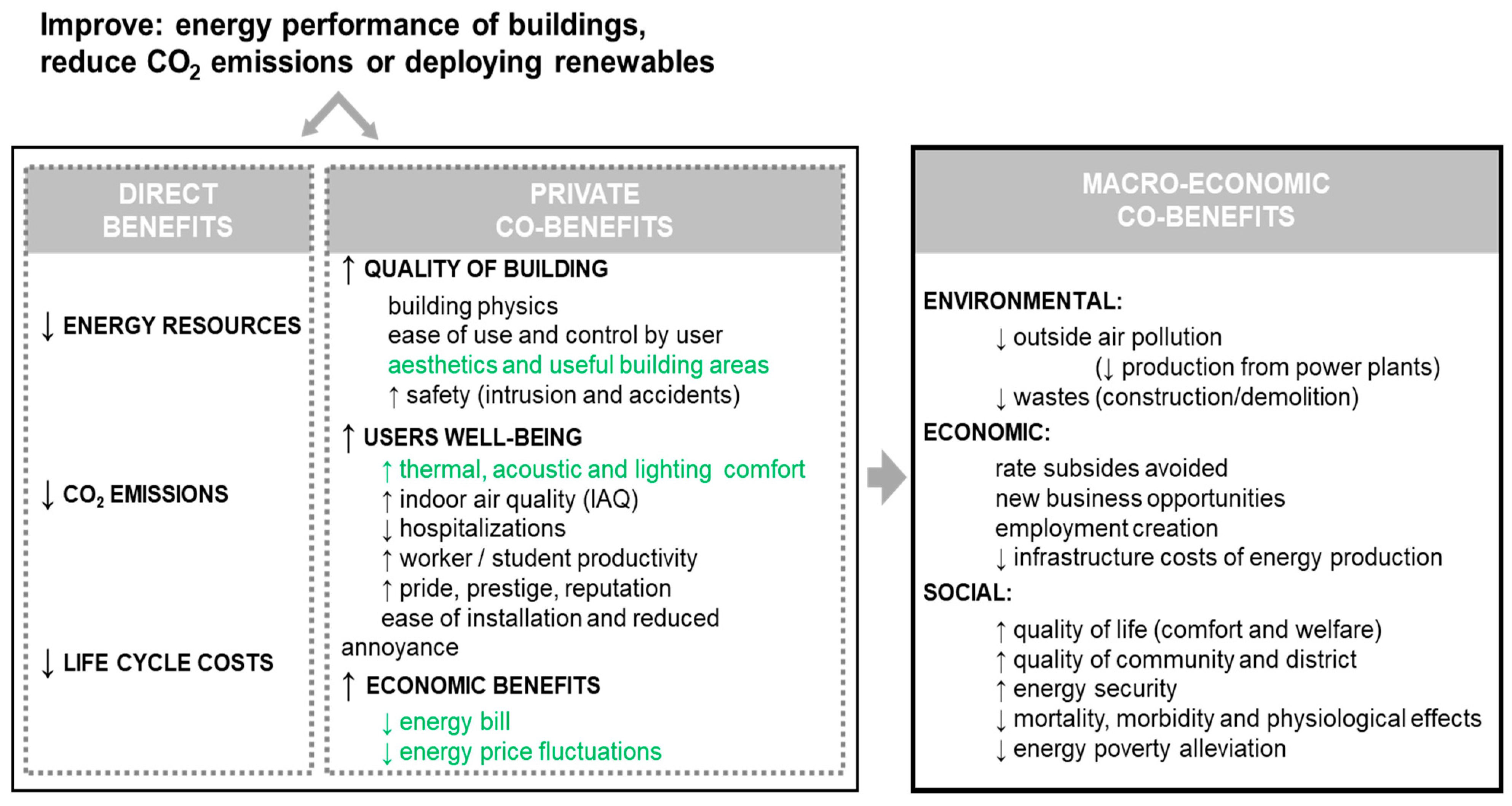
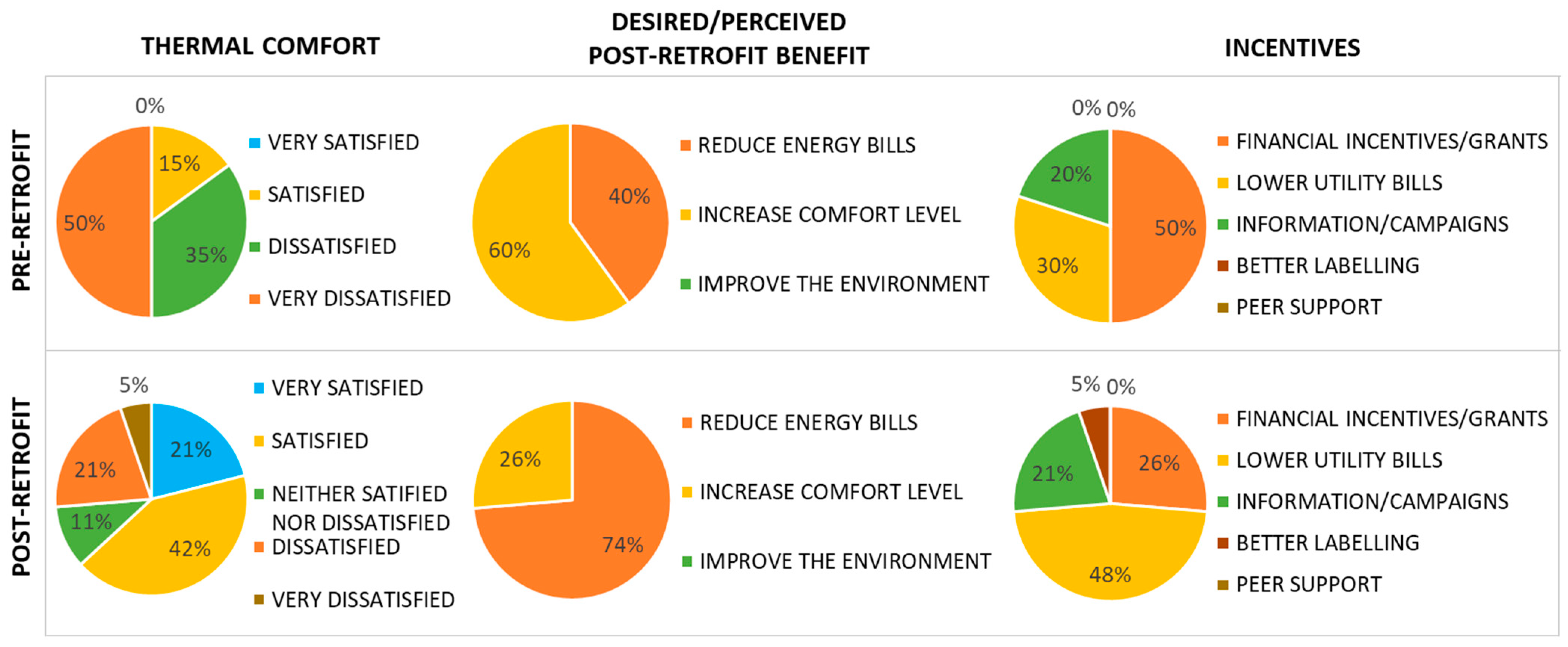
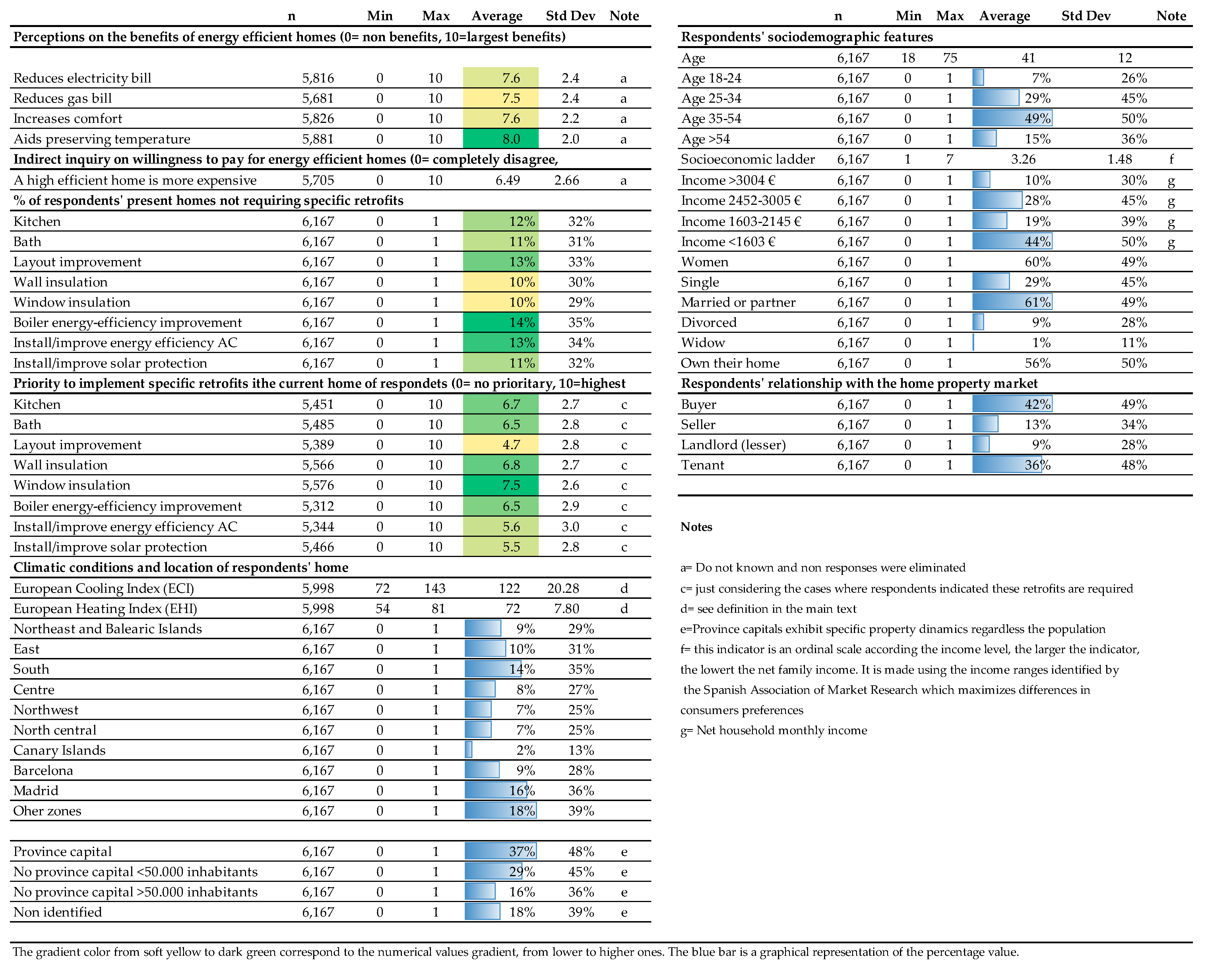
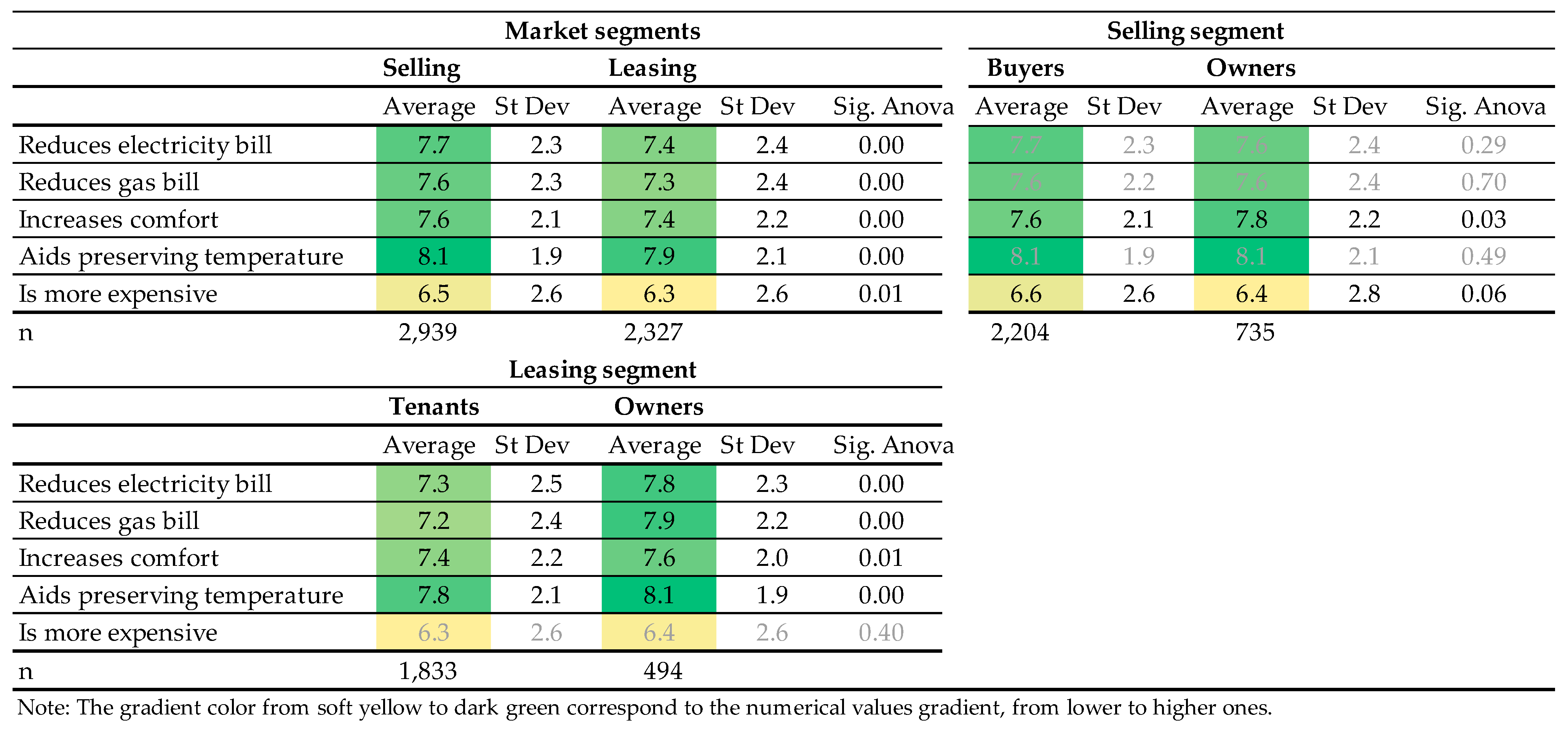
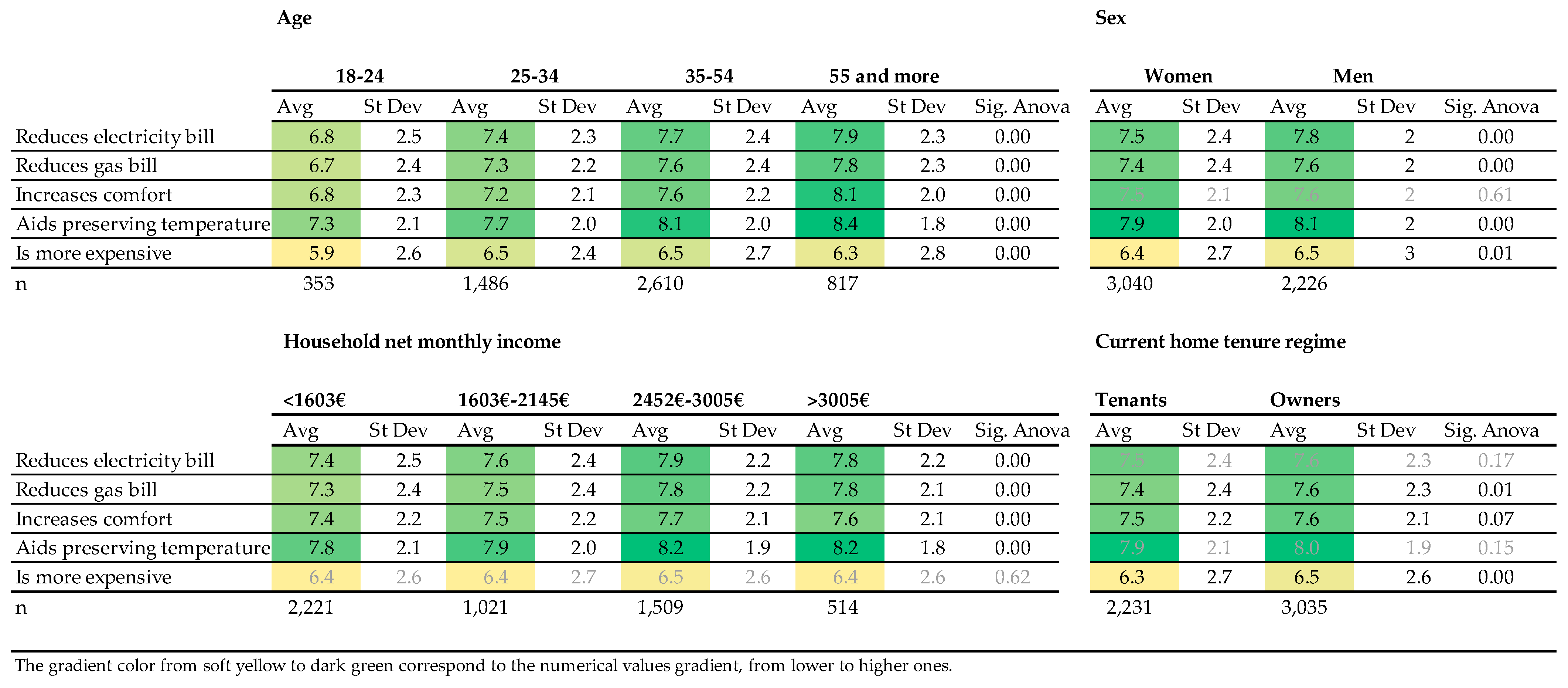


| Residential Building Location | Energy Investment | Co-Benefit Categories in Order of Relevance | After “X” Years | Discount Rate | Net Direct Benefit Cost (B/C) Ratio | Social Net Present Value (NPV) | Net B/C Ratio | Social NPV Including Co-Benefits | Importance of Co-Benefits as The % of Direct or Total Benefits |
|---|---|---|---|---|---|---|---|---|---|
| Ireland source: Clinch et al. [19] | thermal retrofit | Comfort | 31 | 5% | 1.7 | 1111 M€ | 2.0 | 3124 M€ | 75% |
| Ireland source: Clinch et al. [19] | thermal retrofit | Avoided emissions of SOX, NOX, PM10 and CO2 | 31 | 5% | 1.7 | 1111 M€ | 2.0 | 3124 M€ | 75% |
| Avoided excess winter mortality and morbidity caused by energy poverty | |||||||||
| New Zealand source: Chapman et al. [20] | thermal insulation | Reduced hospital admissions | 30 | 5% 7% | 0.44 0.35 | 786 NZ$/house 635 NZ$/house | 1.87 1.51 | 3373 NZ$/house 2725 NZ$/house | 329% |
| New Zealand source: Chapman et al. [20] | Thermal insulation | Reduced days away from school | 30 | 5% 7% | 0.44 0.35 | 786 NZ$/house 635 NZ$/house | 1.87 1.51 | 3373 NZ$/house 2725 NZ$/house | 329% |
| Reduced days off work | |||||||||
| Avoided emissions of CO2 | |||||||||
| Hungary source: Tirado et al. [21] | thermal retrofit | Avoided emissions of SOX, NOX, PM, NMVOC, heavy metals, CO2, etc. | 40 | 5.5% MID scenario DEEP scenario | 0.9 0.9 | 320 M€ 3125 M€ | 2.6 1.7 | 7453 M€ 11,134 M€ | 97% 174% |
| Hungary source: Tirado et al. [21] | thermal retrofit | Comfort | 40 | 5.5% MID scenario DEEP scenario | 0.9 0.9 | 320 M€ 3125 M€ | 2.6 1.7 | 7453 M€ 11,134 M€ | 97% 174% |
| Avoided excess winter mortality caused by energy poverty |
Publisher’s Note: MDPI stays neutral with regard to jurisdictional claims in published maps and institutional affiliations. |
© 2021 by the authors. Licensee MDPI, Basel, Switzerland. This article is an open access article distributed under the terms and conditions of the Creative Commons Attribution (CC BY) license (http://creativecommons.org/licenses/by/4.0/).
Share and Cite
Crespo Sánchez, E.; Spairani Berrio, S.; Onecha Perez, B.; Marmolejo-Duarte, C. Perceived Benefits of Energy Efficiency in the Spanish Residential Market and Their Relation to Sociodemographic and Living Conditions. Appl. Sci. 2021, 11, 875. https://doi.org/10.3390/app11020875
Crespo Sánchez E, Spairani Berrio S, Onecha Perez B, Marmolejo-Duarte C. Perceived Benefits of Energy Efficiency in the Spanish Residential Market and Their Relation to Sociodemographic and Living Conditions. Applied Sciences. 2021; 11(2):875. https://doi.org/10.3390/app11020875
Chicago/Turabian StyleCrespo Sánchez, Eva, Silvia Spairani Berrio, Belén Onecha Perez, and Carlos Marmolejo-Duarte. 2021. "Perceived Benefits of Energy Efficiency in the Spanish Residential Market and Their Relation to Sociodemographic and Living Conditions" Applied Sciences 11, no. 2: 875. https://doi.org/10.3390/app11020875
APA StyleCrespo Sánchez, E., Spairani Berrio, S., Onecha Perez, B., & Marmolejo-Duarte, C. (2021). Perceived Benefits of Energy Efficiency in the Spanish Residential Market and Their Relation to Sociodemographic and Living Conditions. Applied Sciences, 11(2), 875. https://doi.org/10.3390/app11020875








